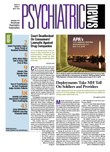Over the past several years, research findings have increasingly demonstrated that the co-occurrence of depression and heart disease has an impact considerably greater than the comorbidity of two common medical disorders. My colleague Charles Nemeroff, chair of the Department of Psychiatry at Emory University School of Medicine, has highlighted some of the findings that have major implications for not only psychiatry but all medical specialties.
There is an unusually high prevalence rate of major depression in patients with coronary artery disease (CAD), far higher than in the population as a whole. The decrease in life expectancy in depressed patients compared with that of the general population is, in part, attributable to an increased risk for death secondary to cardiovascular disease.
Further, patients with major depression are far more likely to die after a myocardial infarction (MI) than are patients with equal cardiac morbidity without major depression.
There is now a well-documented, positive correlation between depression symptom severity and cardiovascular morbidity and mortality. The more severe the depression, the higher the likelihood of developing cardiovascular disease and dying post-MI.
The adverse effect of depression on cardiovascular disease outcome is not limited to MIs, but has also been found for outcome after coronary artery bypass graft surgery and in patients with isolated systolic hypertension. Further, there is evidence supporting depression as an independent risk factor for the development of CAD, perhaps as important as tobacco use. These data are based on more than 40,000 subjects followed for approximately 10 years. The adjusted relative risk for development of CAD in depressed patients is 4- to 4.5-fold that of nondepressed individuals.
Depression is a systemic illness characterized by a number of biological alterations that likely contribute to cardiac morbidity and mortality. Depressed patients, for example, exhibit multiple alterations in immune function, largely in inflammatory cytokines such as interleukin-6 and C-reactive peptide. Depressed patients also exhibit multiple defects in the platelet clotting cascade, all contributing to a clotting diathesis. These include alterations in platelet activation, the platelet “release” reaction, and platelet aggregation. Decreased heart-rate variability, a well-documented risk for MI, has repeatedly been found in patients with major depression.
Fortunately, patients with depression and comorbid CAD respond as well to treatment with select ive serotonin reuptake inhibitor antidepressants as do depressed patients without CAD. Further, the direct effects of these drugs on platelets reduce the risk of thrombus formation.
This remarkable body of evidence linking depression and heart disease now needs to be translated into changes in clinical practice.
Both disorders have an immense impact on individuals and families. Depressed patients are at risk for cardiovascular and cerebrovascular disease, requiring careful monitoring and early intervention. Similarly, patients with cardiovascular disease should be screened for depression.
Only a partnership between psychiatry, internal medicine, family medicine, and cardiology can successfully move these findings from the bench to the bedside. These findings have served as a clarion call for APA to work with the American Heart Association and American College of Cardiology to educate our respective members on this area of paramount importance to patients' health and well-being.
As one of my presidential initiatives, I have begun a dialogue and have interacted with representatives of those groups to enlist their support in informing their physician members of the need to assess their patients for depression (the PHQ-9 is a helpful tool). I also am encouraging them to inform their members and their members' patients about the role of depression as a contributor to greater morbidity and mortality as well as a risk factor for disease development and progression.
We hope these organizations will use their public-information efforts, including their Web sites, to provide this information and to initiate links to psychiatric resources such as APA's HealthyMinds.org Web site.
These organizational interactions need to be supplemented by work at the clinician level. Of course, when we review our patients' general medical status, we should be alert to risk factors as well as to symptoms of cardiovascular disease, and we should inform our patients of what we find. But there is one more way to put our voices into action for our patients. We need to ensure that our colleagues in internal medicine, family medicine, and cardiovascular disease are aware of the impact of untreated depression on patients' cardiovascular status, as well as informed of the positive and protective impact of treatment—or simply, that Treatment Works!▪

